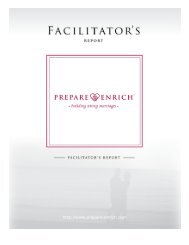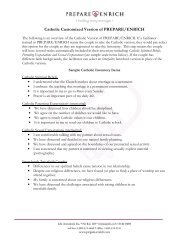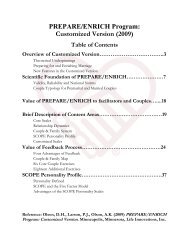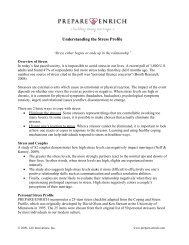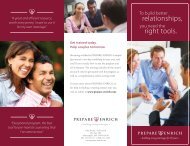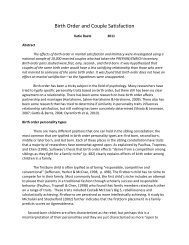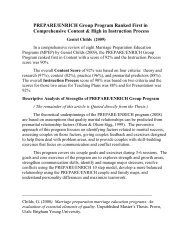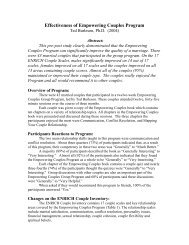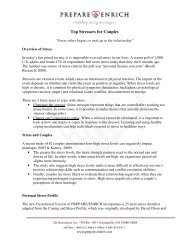Personality, Partner Similarity and Couple ... - Prepare/Enrich
Personality, Partner Similarity and Couple ... - Prepare/Enrich
Personality, Partner Similarity and Couple ... - Prepare/Enrich
Create successful ePaper yourself
Turn your PDF publications into a flip-book with our unique Google optimized e-Paper software.
eport includes a couple typology of the couples. <strong>Couple</strong> typologies described by PREPARE‐ENRICH consist of: Vitalized, Harmonious, Conventional, Conflicted, <strong>and</strong> Devitalized. Eachtypology is often associated with, but not necessarily indicative of relationship satisfaction, asshown in Figures 1 <strong>and</strong> 2.Figure 1: PREPARE/ENRICH Five Types of Married <strong>Couple</strong>sFigure 2: PREPARE‐ENRICH <strong>Couple</strong> Types & Marital SatisfactionVitalized couples are considered the happiest couple type because they have the highestpositive couple agreement (PCA) scores on the PE inventories. Harmonious couples have manystrengths, but not as many as the Vitalized couples. They have high PCA scores in many areas,but often have low scores in the Children & Parenting area. Conventional couples are calledtraditional because they have more strengths in traditional family areas including Children &Parenting, Family & Friends, Traditional Roles, <strong>and</strong> Spiritual Beliefs. However, they often havelower scores on more internal dynamics such as personality issues, communication, <strong>and</strong> conflict6
ParticipantsA national sample of 10,000 married couples completed the PREPARE‐ENRICHassessment. A total of 9,875 individuals reported being of the male gender, <strong>and</strong> 9,885 reportedbeing female, with 240 individuals choosing not to provide their gender. The sample consistedages from 18 to over 70 years old, with the majority (18%) of the population falling into thecategory of 26‐30 years old. The median length of marriage was 1‐5 years (27%), with a rangeof less than one year to over 40 years of marriage. The majority (44%) of participants reportedliving in a suburban area, while 25% lived in a small town, 19% lived in a large city, <strong>and</strong> 12%lived in a rural area. Over half of the participants reported having a higher education, with 31%having some college/technical school, 31% finishing a four‐year college, <strong>and</strong> 26% having agraduate/professional degree. The vast majority (78%) of the sample identified themselves asCaucasian, while smaller percentages of individuals reported various additional ethnicities.Seventy‐seven percent reported their current marriage as their first marriage.ResultsWho Pairs with WhomHypothesis 1 predicted that people would tend to pair with others who share similarpersonalities. To test this hypothesis, a crosstabulation was used comparing each of the fivepersonality scales to the percent of couples within each different pairing (both high, both low,both moderate, <strong>and</strong> one high‐one low). The results were very clear <strong>and</strong> consistent across allfive scales. As Table 1 shows, about two thirds of the couples reported having one individualhigh <strong>and</strong> one individual low on each of the five personality dimensions. A Pearson chi‐squaretest demonstrates that there is significant differences between the frequency of couples whopaired‐up than would be expected by chance (X 2 = 627.7, p
One‐High, 6125 61.3% 6488 64.9% 6387 63.9% 6391 63.9% 6257 62.6%One‐LowTotal 10000 100% 10000 100% 10000 100% 10000 100% 10000 100%Table 1: Frequency of Similar/Dissimilar <strong>Couple</strong>s on SCOPE<strong>Personality</strong> <strong>Similarity</strong> & Marital SatisfactionTwo sets of analyses were applied to assess Hypothesis 2, which predicted thatsimilarities in personality types would correspond to higher reports of relationship satisfactionthan for those in relationships with dissimilarities in personalities. In order to test thishypothesis, the analysis focused on one of the five personality dimensions at a time. A meanvalue for individual satisfaction was obtained from the ratings of each of the 20,000participants, <strong>and</strong> was analyzed according to their couple reports of similarities or dissimilaritieswithin each of the five personality factors.There were mixed findings. In general, there is no relationship between personalitysimilarity <strong>and</strong> marital satisfaction. The mean satisfaction for those with one partner scoringhigh <strong>and</strong> one partner scoring low tends to remain average, but is not consistently higher orlower than the average scores for all three groups of similar personalities (both low, both high,<strong>and</strong> both moderate). However, individuals in relationships with both partners scoring high onany of the five dimensions of personality tend to be happier than those with both partnersscoring low. Table 2 summarizes the results of comparing couples scores within the SCOPEscales to the average individual satisfaction value.SCOPE StatusSCOPE ScaleSocial Change Organized Pleasing EmotionalStabilityMeanSatisfactionMeanSatisfactionMeanSatisfactionMeanSatisfactionMeanSatisfactionBoth Low 16.4 34.9 39.7 41.7 36.1Both High 81.8 57.1 48.9 51.4 55.3BothModerate47.7 45.6 44.4 43.1 44.7One‐High, 45.9 45.1 45.2 45.1 45.5One‐LowTotal 45.1 45.1 45.1 45.1 45.1Table 2: Similarities/Dissimilarities of <strong>Couple</strong>s on <strong>Personality</strong> Scales & IndividualSatisfaction.9
A second set of analyses for Hypothesis 2 focused on each of the five personalitydimensions separately, but was evaluated using positive couple agreement (PCA) to measurecouple satisfaction. As with individual satisfaction, the data did not support the hypothesis thatcouples with similar personalities would report higher satisfaction than those with dissimilarpersonalities. However, couples <strong>and</strong> individuals with differing personalities reported higheraverage satisfaction scores than those couples who both scored low in the five personalitydimensions. Results are summarized in Table 3.SCOPE StatusSCOPE ScaleSocial Change Organized Pleasing EmotionalStabilityMeanSatisfactionMeanSatisfactionMeanSatisfactionMeanSatisfactionMeanSatisfactionBoth Low 10.8 28.0 31.4 33.0 26.0Both High 85.1 51.7 45.3 46.2 53.0Both 49.9 41.5 39.0 38.4 40.3ModerateOne‐High, 35.9 38.7 38.9 39.1 39.1One‐LowTotal 39.1 39.1 39.1 39.1 39.1Table 3: Similarities/Dissimilarities of <strong>Couple</strong>s on <strong>Personality</strong> Scales & <strong>Couple</strong>Satisfaction (PCA).<strong>Personality</strong> Traits & Marital SatisfactionHypothesis 2 was rejected, but the data revealed interesting differences betweencouples either both scoring high or both scoring low on the five factors of personality.Hypothesis 3 predicted that couples whom both report low scores in personality traits wouldhave lower satisfaction in their relationship than those who both report high scores. As Tables2 <strong>and</strong> 3 show, the findings support this hypothesis across all five personality scales, in bothindividual <strong>and</strong> couple satisfaction ratings. T‐tests indicate that each reached significance withindividual satisfaction ratings for both low <strong>and</strong> both high of: social (t = 213.5, p
consisting of: social (t = 74.3, p
In order to further investigate the results, the couples were divided into each of the 5couple types identified using PREPARE‐ENRICH, with 2,000 couples per type. A cross‐tabulationwas used for each of the five personality scales <strong>and</strong> compared the percent of couples withineach of the couple types to their personality similarities/dissimilarities. According to PREPARE‐ENRICH, Vitalized couples tend to be the happiest, followed by Harmonious couples,Conventional couples, Conflicted couples, <strong>and</strong> the least happy being Devitalized couples. Asshown in Table 4, the results support the previous data which indicated that couples who bothscore high in the five personality scales tend to be more satisfied in their relationships thanthose who both score low, when associating the five couple typologies with marital satisfactionlevels.Hypothesis 5 predicted that couples with a typology of Vitalized (high satisfaction) willmost often have both partners scoring high in all five SCOPE scales, whereas Devitalized (lowsatisfaction) couples will most often have both partners scoring low in all five SCOPE scales.Table 4 indicates that hypothesis 5 is generally supported in terms of Vitalized couples, asVitalized couples consisted of the highest percentage of couples scoring both high across all fivepersonality scales. However, contrary to the previous findings of this study, Devitalized couplesdid not consistently have the highest percentage of couples scoring low across all fivepersonality scales.Further, the data indicates that that those couples who both scored high on theemotional stability, pleasing <strong>and</strong> organized scales had the greatest likelihood of being Vitalized,which is associated with the highest satisfaction. These results differ slightly from the dataobtained to test hypothesis 4, when the individuals’ <strong>and</strong> couple’s reported satisfaction wascompared to the couples’ personalities.DiscussionThe current study examined a r<strong>and</strong>om sample of 10,000 married couples to test howvariations in the SCOPE personality scales (based on the “Big Five”) effect attractions betweenindividuals <strong>and</strong> their relationship satisfaction. The hypotheses were tested regarding whetherpersonality similarity relates to marital satisfaction, to what extent certain personality factorseffect marital satisfaction, <strong>and</strong> if there is evidence regarding whether or not opposites attract.First, the debate regarding who is attracted to whom was examined. The hypothesiswas the individuals would be more attracted to those who share similar personalities withthemselves, or in other words, “like attracts like.” The results indicated a rejection of thishypothesis, as approximately two‐thirds of the couples surveyed found that one partner scoredhigh <strong>and</strong> one partner scored low across all five personality scales. This is consistent withprevious researching stating that spouses are not likely to have more similarities than expected12
y chance (Gattis et al., 2004). The most interesting aspect of this finding is that althoughpeople are generally attracted to individuals with different personalities, the frequency ofcouple typologies were equal, implying that there is no significant correlation betweenpersonality similarities/dissimilarities <strong>and</strong> relationship satisfaction.Two primary marital satisfaction scores were used, individual satisfaction <strong>and</strong> couplesatisfaction (PCA). These scores were compared to couple personality types <strong>and</strong> later to thecouples’ typologies within PREPARE‐ENRICH. The primary finding was that, across all fivedimensions, couples both scoring high on each of the five scales were more satisfied thancouples both scoring low in the five personality scales. This is noteworthy because although itis generally accepted that a variety of personality combinations may result in successfulrelationships, it appears that the “best” combination for a happy couple is for both couples toscore high on the five factors.Overall similarities in personality were not related to marital satisfaction, which isconsistent with recent research (Dyrenforth et al., 2010; Shiota & Levenson, 2007). In thesestudies, couples were more satisfied in relationships where at least one person reportedaverage‐to‐high scores within the five dimensions of personality. This may suggest that interms of relationship satisfaction, it is more important to have complimentary personalitiesthan to have similar personalities. As proposed by Shiota <strong>and</strong> Levenson (2007), similarities maybe more important in early relationships than in later years when conflicts tend to arise. Forexample, it may eventually become problematic for both partners to be extremely open tochange <strong>and</strong> new ideas because conflict is likely to arise when neither partner is able to bedecisive. In contrast, if one person is willing to go with the flow <strong>and</strong> allow their partner to takecharge, task completion may be less stressful.The idea of complimentary personalities over similar personalities is also evident in thecurrent data. <strong>Couple</strong>s with personality traits of one high <strong>and</strong> one low report a consistent,average level of satisfaction, compared with to the variability of satisfaction levels for thosethree groups of similar personalities (both high, both low, <strong>and</strong> both moderate). An explanationfor the inconsistency of marital satisfaction within the similar personality couples may be dueto age differences. Shiota <strong>and</strong> Levenson (2007) compared personality with marital satisfactionover a 12‐year longitudinal study consisting of various age groups. Their data indicated changesin satisfaction at different time periods, corresponding to personality similarities/differences.Depending on life events, it is implied that no particular pairing of personalities will result inhigh scores of life‐long satisfaction, because unlike our personalities, our lives are constantlychanging.Though there is no definite trait that can predict relationship satisfaction, the currentstudy found that all five personality scales relate to marital satisfaction. Additionally, the social,13
change, <strong>and</strong> emotionally steady scales having the greatest relationship to individual <strong>and</strong> couplesatisfaction. This is evident by the significant differences in average satisfaction reported bycouples with both high or both low scores in social, change <strong>and</strong> emotional stability.However, when personalities were compared to the couple typologies across all fivepersonality dimensions, the organized, pleasing, <strong>and</strong> emotionally stable scales were the mostimportant predictors of a vitalized typology. The vitalized couple is often considered the mostsatisfied <strong>and</strong> is based on various dimensions within the relationship rather than self‐reportedsatisfaction. It is possible, therefore, that the satisfaction ratings correlated to couple typologyis more reliable than self‐reported satisfaction. The present research finds that the organized,pleasing, <strong>and</strong> emotional stability dimensions are the most important predictors of overallrelationship satisfaction. This finding is consistent with other research regarding theimportance of neuroticism (emotional stability) (Gattis et al. (2004); Karney & Bradbury (1995);Kelly & Conley, 1987), but also adds to the work of Watson, Hubbard, <strong>and</strong> Weise (2000) whofound extraversion (social), conscientiousness (organization), <strong>and</strong> agreeableness (pleasing) tobe replicable <strong>and</strong> rather strong predictors of marital satisfaction.Finally, when the study compared PREPARE‐ENRICH couple typologies to the frequencyof SCOPE status groups (both low, both high, both moderate, <strong>and</strong> one high‐one low), it wasfound that the Vitalized couples were most likely to have both partners scoring high across allfive SCOPE scales. This is supported by the data indicating that couples scoring both high in thepersonality dimensions have higher marital satisfaction. However, contrary to previousfindings, the Devitalized couples were not always most likely to have both partners scoring lowacross all five SCOPE scales. The data suggests that although the personalities of partners seemto matter for judgments of satisfaction, it is not the key to overall marital happiness.Strengths & LimitationsStrengths of this study include its large, r<strong>and</strong>omly selected sample <strong>and</strong> the measures ofits constructs. The sample of 10,000 couples was obtained anonymously <strong>and</strong> was gatheredfrom pre‐existing data within the PREPARE‐ENRICH database from couples who chose to takethe PREPARE‐ENRICH couple assessment. To ensure diversity <strong>and</strong> variability within therelationships, two thous<strong>and</strong> couples from each of the five identified marital types were selectedfor comparison. PREPARE‐ENRICH boasts a high degree of reliability <strong>and</strong> validity <strong>and</strong> is acommon measure of relationship satisfaction. The SCOPE personality scale is a measure of theBig Five personality traits <strong>and</strong> is a part of the PREPARE‐ENRICH assessment. PREPARE‐ENRICH isa convenient way to obtain both personality <strong>and</strong> relationship satisfaction scores from a nonbiassample. <strong>Personality</strong> data was compared to individual <strong>and</strong> couple satisfaction, as well as theoverall couple typologies.14
The cross‐sectional nature of the data serves as a limitation because a direct influencebetween personality <strong>and</strong> satisfaction cannot be determined by correlational data. Though itwas impossible to account for outst<strong>and</strong>ing variables within the relationship which may affecteach spouse’s satisfaction, the use of couple typologies compared to personality types may aidin this limitation. Because the typologies are based on a variety of dimensions within therelationship <strong>and</strong> correspond to a certain level of satisfaction, the comparison of typology topersonality similarities may account for discrepancies within the relationship which are not adirect result of personality traits.Since the study measured the mean scores of individual satisfaction, it is limited by theinability to distinguish between what Dyrenforth et al. (2010) called partner effects <strong>and</strong> actoreffects. <strong>Partner</strong> effects estimate the relationship between a person’s personality <strong>and</strong> his or herspouse’s satisfaction <strong>and</strong> actor effects estimate the relationship between a person’s personality<strong>and</strong> that person’s satisfaction. Since the data does not display individual satisfaction in relationto both partners’ separate personality scores, it cannot be determined whether personalitydifferences/similarities effect the individual satisfaction of either spouse.ReferencesBotwin, M. D., Buss, D. M., & Shakelford, T. K. (1997) <strong>Personality</strong> <strong>and</strong> mate preferences: Fivefactors in mate selection <strong>and</strong> marital satisfaction. Journal of <strong>Personality</strong>, 65, 107 – 136.Buss, D.M. (1985). Human mate selection. American Scientist, 73, 47 – 51.Dyrenforth, P. S., Kashy, D. A., Donnellan, M. B., & Lucas, R. E. (2010). Predicting relationship<strong>and</strong> life satisfaction from personality in nationally representative samples from threecountries: The relative importance of actor, partner, <strong>and</strong> similarity effects. Journal of<strong>Personality</strong> <strong>and</strong> Social Psychology, 99, 690 – 702.Fowers, B. J., & Olson, D. H. (1989). Predicting marital success with PREPARE: A predictivevalidity study. Journal of Marital <strong>and</strong> Family Therapy, 12, 403 – 413.Gattis, K. S., Berns, S., Simpson, L. E., & Christensen, A. (2004). Birds of a feather or strangebirds? Ties among personality dimensions, similarity, <strong>and</strong> marital quality. Journal ofFamily Psychology, 18, 564 – 574.Karney, B.R., & Bradbury, T.N. (1995). The longitudal course of martial quality <strong>and</strong> stability: areview of theory, method, <strong>and</strong> research. Psychological Bulletin, 118, 3‐34.15
Kelly, E.L, & Conley, J. J. (1987). <strong>Personality</strong> <strong>and</strong> compatibility: A prospective analysis of maritalstability <strong>and</strong> marital satisfaction. Journal of <strong>Personality</strong> <strong>and</strong> Social Psychology, 52, 27 –40.Lester, D., Haig, C., & Monello, C. (1989). Spouses’ personality <strong>and</strong> marital satisfaction.<strong>Personality</strong> <strong>and</strong> Individual Differences, 10, 253 – 254.Luo, S., Chen, H., Yue, G., Zhang, G., Ahaoyang, R., & Xu, D. (2008). Predicting maritalsatisfaction from self, partner, <strong>and</strong> couple characteristics: Is it me, you, or us? Journal of<strong>Personality</strong>, 76, 1231 – 1266.Luo, S., & Klohnen, E. C. (2005). Assortative mating <strong>and</strong> marital quality in newlyweds: A couplecenteredapproach. Journal of <strong>Personality</strong> <strong>and</strong> Social Psychology, 88, 304 – 326.Olson, D. H. & Larson, P. J. (2008). PREPARE/ENRICH: Customized Version. Life Innovations, P.O.Box 190, Minneapolis, MN 55440.Popenoe D. & Whitehead R.D. (2010). The state of our unions 2010. Piscataway, NJ: NationalMarriage Project, Rutgers University.Shiota, M. N., & Levenson, R. W. (2007). Birds of a feather don’t always fly farthest: <strong>Similarity</strong> inbig five personality predicts more negative marital satisfaction trajectories in long‐termmarriages. Psychology <strong>and</strong> Aging, 22, 666 – 675.Sprecher, S., & Duck, S. (1994). Sweet talk: The importance of perceived communication forromantic <strong>and</strong> friendship attraction experienced during a get‐acquainted date.<strong>Personality</strong> <strong>and</strong> Social Psychology Bulletin, 20, 391 – 400.Tan, D. T. Y., & Singh, R. (1995). Attitudes <strong>and</strong> attraction: a developmental study of thesimilarity‐attraction <strong>and</strong> dissimilarity‐repulsion hypotheses. <strong>Personality</strong> <strong>and</strong> SocialPsychology Bulletin, 21, 975 – 986.Watson, D., Hubbard, B. & Weise, D. (2000). General traits of personality <strong>and</strong> affectivity aspredictors of satisfaction in intimate relationships: Evidence from self‐ <strong>and</strong> partnerratings.Journal of <strong>Personality</strong>, 68, 413 – 449.16




